Sealing profiles, prototypes & special products
Faster, better, different – since 1997 we are putting our best efforts into fulfilling our customer’s wishes according to this motto.
This includes the development of special solutions:
- cut sealing profiles
- extruded rubber- & sponge rubber profiles
- coating
- prototype construction
- cut-outs, strips and sheets of various material
You are unsure as to which material suits your purpose best?
Send your us your request: info@windowsafe.de
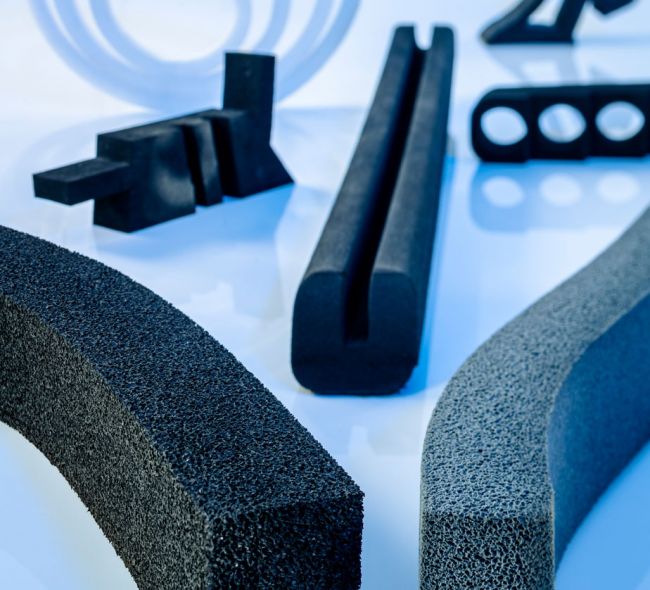
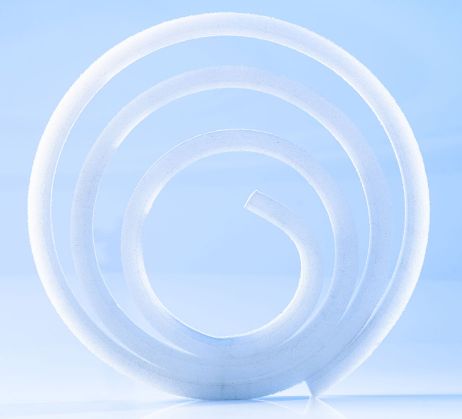
Cut sealing profiles
Non-extruded profiles are usually cut by water jet or milled. The lengths are being produced by gluing segments together or (with thermoplastic materials) by welding them.
Advantages of non-extruded profiles:
- There are no minimum quantities to take into account.
- Small quantities or even initial batches can be manufactured without difficulty.
- There is no need for either special tools or type samples.
- Delivery times and costs can be reduced significantly.
Extrusion requires certain materials. Non-extruded profiles can be made of all commonly used materials – including cell rubber.
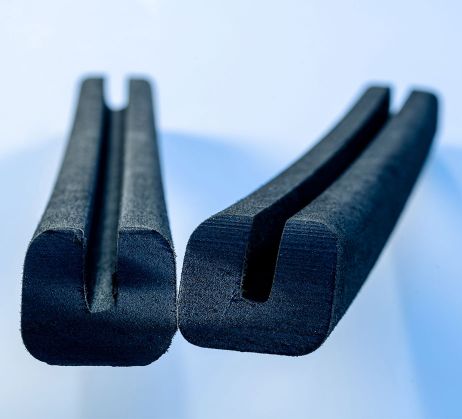
Limitations concerning non-extruded profiles:
When it comes to large quantities extrusion is usually more efficient and economic then other methods. An exception to the rule is cell rubber that is usually not extruded due to technical difficulties.
The non-extrusion manufacturing of elastomer profiles (cell, sponge and solid rubber) is usually limited to simple geometric shapes. Extrusion is often more suited for realizing complex outlines.
Great profile lengths are a problem for non-extrusion methods. Most profiles are being cut from blocks of raw material. Those in turn define the maximum length of a single segment (usually < 2.000 mm).
If the profiles are required to be longer gluing or welding (PE foam) is needed
The following materials can be used for cutting:
Cell rubber is difficult to extrude but due to its properties (softness, water tightness, flexibility) essential to sealing applications. Therefore non-extruded cell rubber profiles are very commonly used especially in the building sector.
Since all three materials can also be extruded alternative production methods are only used when it comes to small quantities and simple rectangular shapes.
Extruding cell polyethylene is a process that requires a lot of technology, experience and knowhow. Therefore smaller quantities (up to 5.000 meters), prototypes or very complex shapes are often cut or milled to keep efforts and expenses to a minimum.
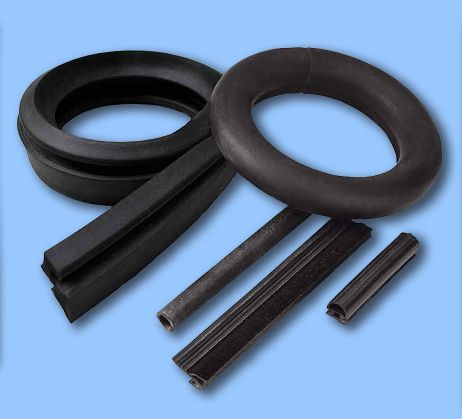
Extruded profiles & clamping sections
Sealing profiles and clamping sections are usually manufactured by extrusion and made of elastomers such as sponge rubber, soft rubber or silicone.
During extrusion the viscous raw material is pressed continuously through a die resulting in profiles with the exact transversal section of the tool. The combined pressing of two different materials is called “coextrusion”.
Because of their elasticity and their watertight closed-cell structure cell rubber profiles are a convenient and economically priced alternative especially in the wide field of sealing tasks.
Soft rubber profiles
Soft rubber profiles are the most commonly used profiles when it comes to sealing and edge protection. Depending on the rubber qualities used for production they can be resistant to weather, aging, heat and/or chemicals. The most popular quality is EPDM which fits a lot of purposes in many different industries due to its properties.
Sponge rubber profiles
Sponge rubber profiles are softer and more flexible than soft rubber profiles. If large quantities are needed they are also more cost efficient than cell rubber profiles because they can be extruded. Thus sponge rubber profiles are very commonly used:
- for sealing tasks
- for protecting edges
- for damping vibrations and oscillation
- for transport and stocking purposes
As with cell and soft rubber the properties of sponge rubber profiles (mechanical and physical properties as well as resistances to weather, ageing or temperature) are depending on the raw materials rubber mixture. Thus EPDM sponge rubber is highly ozone and weather proof but not resistant to oil and fuels. The latter two have in turn no impact on nitrile rubber (NR) mixtures.
TPE profiles
Other than classic elastomers TPEs (thermoplastic elastomers) consist of materials with both thermoplastic and elastomeric properties. They become pliable or mouldable above certain temperatures and solidify upon cooling but without losing their elasticity. Processing is easy and cost efficient even in small quantities. TPE profiles contain no plasticizers or silicone. They are easily recyclable and environmentally acceptable.
Silicone profiles
Silicone provides a lot of properties that classic elastomers can’t offer. Usually it is odour- and tasteless, water-repellent and easy to clean. Therefore silicone profiles are frequently used in the pharmaceutical and food industry where clean or sterilized environments are vital.
For the building sector silicone profiles offer high resistance to weather and UV radiation as well as to especially high and low temperatures.
In addition they are manufactured without the use of plasticizers and available in a wide range of shore hardness . All silicone rubber types exhibit excellent mechanical properties such as high pressure and tensile resilience.
For meeting specific demands silicone profiles can be customized by modifying their shore hardness and colour or by making them thermally or electrically conductive.
Coextrusion profiles
Coextrusion is the simultaneous manufacturing of two or more materials.
A typical example are flexible edge protectors in conjunction with sponge rubber sections.
Here the edge protection part (that is e.g. made of EPDM soft rubber with imbedded steel insert) is bonded to a sponge rubber sealing section (e.g. made also of EPDM) via coextrusion.
This type of profile combines the function of covering and thus protecting sharp edges with a sealing effect.
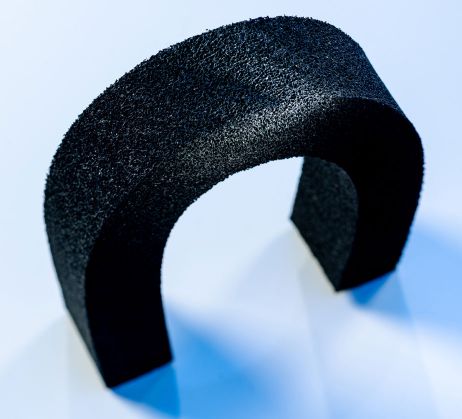
Coating
By coating the surface of a gasket or a profile the original properties of its material can be modified and enhanced. For example the heat resistance as well as the friction coefficient can be improved considerably by a polytetrafluorethylene (PTFE) coating. In addition most materials can be equipped with adhesives.
Standard coating types for elastomers:
The standard windowSafe® adhesive coating is a solvent free, environmentally acceptable double-sided adhesive tape on a special paper medium. It is physiological harmless and exhibits excellent weather and ageing resistance.
- Material: acrylate
- Temperature resistance: -40°C up to +120°C
- Glue type: acrylate
- Medium: special paper
- Cover: silicone paper, brown
Thanks to its distinct viscoelastic properties it is very well fitted for coarse celled material.
The windowSafe® standard PTFE coating is a fluoropolymer system with excellent gliding properties that is especially suited for flexible materials. Even without mechanical pre-treatment it adheres very well to rubber materials. Instead of a closed layer it forms a shingle-like structure that is able to withstand elongation without being damaged. Thanks to this shingle structure it is particularly suited for elastic components which are undergoing deformation during application, e.g. sealing gaskets that are mounted on mobile elements in doors or windows.
- Coating thickness: 10 – 25 μm
- Colour: black
- Friction coefficient: 0.07
- Surface finish: < 2 μm
- temperature resistance: - 40 up to + 150°C
- Flammability: not flammable
- Bending strength: excellent (48.000 folding cycles)
The coating was specially developed for rubber but can also be applied to other materials. If complex shapes are being coated the coating thickness can vary.
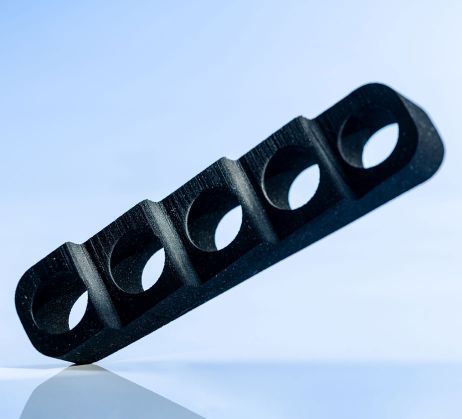
Prototype construction ...
Prototypes are an important aspect of every product development process.
Usually they mark the starting point for testing function, chemical and mechanical abilities as well as for revision, adaptation and improvement.
Thanks to many years of experience in the sealing sector as well as with very different production methods we are able to provide prototypes and initial batches made of cellular rubber, soft rubber or other materials.
This way our customers can put their products to test without buying expensive tools or losing time by waiting for type samples.
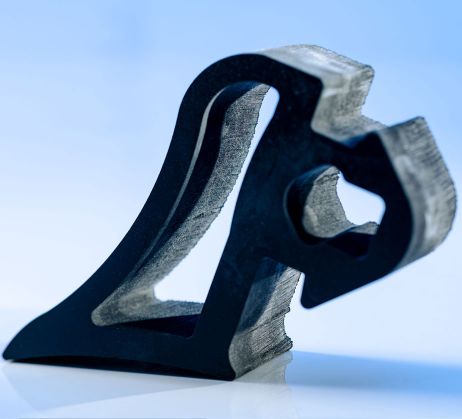
... instead of extrusion or moulding die tools
Especially when developing a new sealing profile or a moulded part the manufacturing of separate die tools in every new stage of the process is very elaborate.
It causes high costs, a lot of effort and long delays. To sum it up: constantly designing new extrusion or moulding dies is often not a realistic option.
This problem can be avoided by a separate prototype production.
Even if it is often complex and requires a lot of experience with materials and manufacturing techniques it is usually faster, more flexible and a lot less costly than the manufacturing of samples using the final production processes like extrusion or moulding.
Send your us your request: info@windowsafe.de